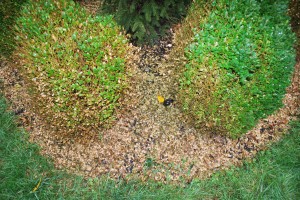Boxwood Blight (Calonectria pseudonaviculata)
Overview:
- Fungal infection – caused by Calonectria pseudonaviculata
- Characterized by leaf spots, rapid defoliation, and stem lesions
- Leaves turn brown or yellow, with darker boarders
- Stem lesions are black streaks or cankers
- Spreads rapidly
- Causes leaves to DROP-OFF
- (hypersensitive response)
- COOL/wet = black cankers & white hyphae
- Anytime we have prolonged 60F+ rain events
- Sticky spores – spreads VERY easily in water
Management:
- Removed diseased leaves, stems, plants, soil (persistent
for LONG periods) when DRY - Protective fungicide applications
- Fungicides applied at regular intervals
- [M05]: Chlorothalonil
- [M05 + 1] Chlorothalonil + Thiophanate methyl
- [11] Trifloxystrobin + [7] Fluopyram
- [11] Trifloxystrobin + [3] Triadimefon
- [M03] Mancozeb
- [12] Fludioxonil
- [3] Tebuconazole
- USPEST Boxwood Blight Risk Model
- If BWB is important to your business – Use the USPEST – PUSH Alerts – (click here) – to setup weekly email alerts. Create an account, watch the tutorial, and then set up your subscriptions. You select which locations (as many as you like), days you want to receive emails, and what you would like to receive alerts about (BWB and a variety of other pests and diseases). Rutgers is not directly affiliated, however this is an incredible tool.
- Watch for successive rainy, 60F+ days
Boxwood Blight Quick Diagnostic:
- Take foliage, dampen it, place into a Ziploc bag or container
- If white and fluffy: Boxwood Blight
- If bumpy and peach: Volutella
Boxwood Resources:
- CLICK HERE FOR 2020 – Boxwood blight resistant cultivar rankings (USDA).
- Click here for additional BWB research updates
- CLICK HERE FOR A FREE DOWNLOAD – BOXWOOD HEALTH, Best Management Practices Production and Landscape Management (18 pages – Version 3.0)
- Click here for more BWB initiatives
- Click here for more detailed Boxwood blight posts with many other links and background information





Disclaimer – Materials do not cover all possible control scenarios and are intended for licensed professionals. Tradenames do not imply endorsement and are used as examples. You must strictly follow the label for each compound prior to use. Rutgers is not responsible form is used materials or damages thereof. The label is the law. Labels will provide detailed information on use and restrictions. Additionally, application intervals, compatibility, surfactant use, PHI, PPE, important and other key information is described in detail. Always discuss treatments with your local agents. Note: Neonicotinoids can only be legally applied in commercial agriculture settings by licensed applicators. Guidelines and recommendations made in this presentation are specific to the state of New Jersey.
